Why Dornick Hills should be Restored
by Chris Clouser
Ever since the return from a trip to Oklahoma to conduct research about the career of Perry Maxwell, the memories of courses like Southern Hills, Prairie Dunes, Oklahoma City and others seem to be so visible, but with one course it has become difficult to really “see” the work of Maxwell as he designed the course. The Dornick Hills Country Club has seen perhaps more renovation than any other major course in the career of Maxwell. So a side project of mine has been to trace the evolution of the course from inception through today to possibly identify areas that could be restored or changed to provide a greater feeling of what the original course was intended to be. In researching this, the feeling of something truly being lost has been overwhelming. How can that be regained?
First, we have to understand what was actually lost over time and what can we physically do to bring that back to the ground the course sits on today.
Maxwell was originally a banker in Ardmore that loved to play tennis. His wife, Ray, began to think that tennis was taking its toll on Perry and suggested that he take up golf and gave him a copy of Scribners Magazine that featured an article on the National Golf Links of America in Southampton, New York. Perry quickly became enamored with the game and developed a passion for it. Going so far to follow Francis Ouimet to watch him win the 1914 US Amateur championship. A few years later the Maxwells, along with their three daughters were quickly outgrowing their residence within Ardmore and wanted a location on the outskirts of the city. Ray had spotted a piece of land just north of town that she thought would be ideal. It was part of the local “poor” farm and was up for auction. The Maxwell’s bought it and erected a house in the southwest corner of the property. An abstract on the land reads as follows:
The property was previously deeded to Carter County for use as a “county poor farm.” The county decided it was not needed and unsuitable for such purposes and on March 19, 1914, the court of Carter County, Oklahoma, after hearing the resolution of said Board of the County Commissioners, and taking testimony of witnesses and being fully advised in the premises, finds it to be best interest of Carter County, Oklahoma, that said farm be sold. Land to be sold in a public auction. Said bids were opened and we (Carter County Commissioners) find that the bid of P. D. Maxwell was the highest and best bid, same being for $7,025.00, same being more than 90% of the appraised value.
The idea of the golf course began before Maxwell actually purchased the land. It was actually at the suggestion of Ray that he build his own course since there were none in the area. Originally, the intent was to build his own private course that made use of the natural features of the plot of land to provide exercise and enjoyment of the game that he had grown to love over five short years. The bulk of the land was a valley with a meandering creek and a small pond. The highest elevations on the property were on the perimeter with a sharp cliff on the northern rim and two steep hills on the southern and eastern edges. The eastern edge is where the farm was located. The original course was comprised of four holes and was routed in 1914. A description of the original routing is provided below from a local resident of Ardmore at the time, Dr. James Watson. Below the description is a hand drawing of the original routing.
The original course consisted of only four holes. The first tee was just north of the Clubhouse; just behind the first tee was a pro shop possibly ten by twenty feet building. The first Pro was Hamp Veal who later became the pro at Bartlesville, Oklahoma. He lived in the home near the Springer Road west of the clubhouse, which is now gone. The course layout was this, you drove north from the tee which is now the West nine. The second hole was the same as now, you drove back south toward the clubhouse and went west to the now third hole green. From there you went across a small creek to a tee and played on the north side of the creek and east back to a green just north of the second tee.
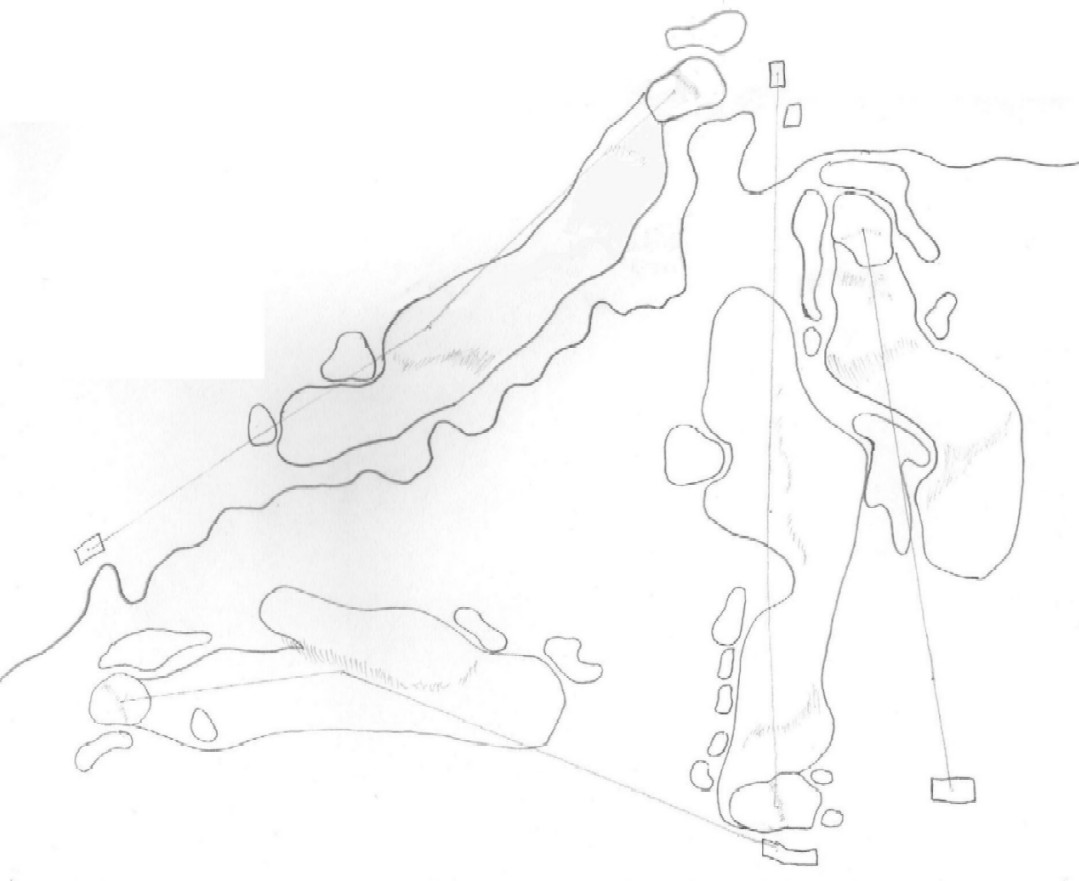
This was the original layout of the four hole course.
Soon after the completion of the four hole routing, the idea of the Dornick Hills Country Club was proposed to Maxwell and he organized the collection of the first dues from those willing to help cover the costs of completing the course. The original dues were $100 and numerous people signed up. Once the funds were received Maxwell began the construction of the west nine holes that now consist of the second nine on the course. This required the elimination of the fourth hole in the original routing, which now serves as the turf and tree nursery on the grounds just west of what is now the 11th tee. The bunkering from the original fourth hole was used on the famous 16th hole only along the right side of the fairway. The construction of the west nine would culminate in 1918.
The major impact of the design was that the course was the first in the state to have grass greens as opposed to the sand greens that were the norm in the region. This would create an instant demand around the state that would lead to a large part of Maxwell’s early work in Oklahoma and an instant boom for other architects within the state. It was also the first course in the state to join the USGA and would be the lone member in Oklahoma until almost 10 years later.
The significance of the design itself is also notable as the opening nine holes of the course were a direct influence of Maxwell’s study of the National Golf Links of America. Maxwell designed the nine holes with no less than five conceptual copies of the National and perhaps more. The 10th was a version of the famous Leven hole. The 12th was a version of the Bottle hole originally. The 16th is a version of the Long hole, but today lacks the bunkering to reflect this idea. The 17th was a version of the famous Short hole. Other holes were obviously influenced by Macdonald as there was a possibly a version of the Knoll, Hog’s Back, Road and Redan on the final version of the 18 hole course.
Due to the death of his wife in 1919, Maxwell decided to switch careers from banking to golf course architecture. His first project was to add a second nine holes to the Dornick Hills course. This process would take another four years and was completed in 1923. Before undertaking this portion of the design of his home course, Maxwell had toured many of the top courses in Scotland and the United States. Included in those journeys were courses such as Muirfield, Prestwick, Garden City, Pine Valley and the two courses that would inspire the bulk of his designs in the early part of his career, the National Golf Links of America and The Old Course at St. Andrews. The use of many of the same concepts used on these courses can be found throughout Maxwell’s career and also at Dornick Hills.
The golf course at Dornick Hills used a core routing scheme with two sets of nine holes returning to the clubhouse with one other hole finishing near the clubhouse, as with almost all of Maxwell’s designs in his career. As indicated with the drawing of the completed 18-hole routing below, the bunkering style was reminiscent of other early American architecture found at courses like Garden City.
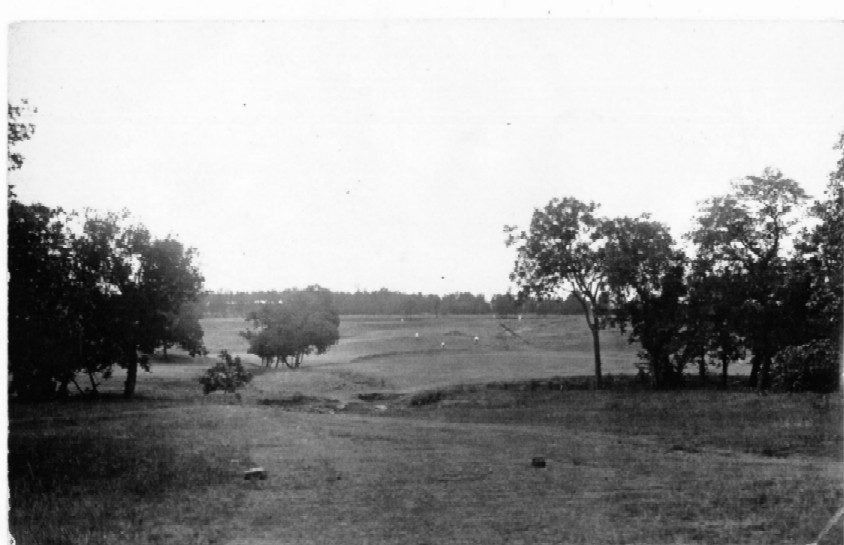
The original 11th hole (circa 1915)
The course also contained some other novel features. The 12th hole was originally designed with a double fairway. The 10th, 11th and 18th holes used a merged fairway that provided for various avenues of play on all three holes. The 6th used a type of cross hazard similar in nature to the famous Hell’s Half Acre used on the 7th hole at Pine Valley. Another key feature was the way that Maxwell used the terrain to create a variety of shots from different angles and lies. Downhill approaches were used on holes like the 5thand 7th. Elevated tee shots were used on the 1st, 10th, 12th, 15th and 17th. Uphill semi-blind approaches were equally provided to elevated greensites on many holes as well.
The greens though were the spotlight of the course, not only with the famous Maxwell undulations but in the location of the putting surfaces as well. The 16th green is perhaps one of the shining examples from the Golden Age of great holes that would never be replicated today. The green is perched on top of a 40 foot cliff edge and requires a blind approach to one of the most undulating greens on the course.
It is believed though that many of the bunkers indicated on the drawing below of the course from 1926 were indeed grass bunkers as Maxwell referred to the number of bunkers in a 1935 American Golfer interview, “You will never see it until you play each of its eighteen holes, for the simple reason that it does not obtrude and is not an eyesore. Not a square foot of earth that could be left in its natural state has been removed. No pimples or hummocks of alteration falsify its beauty. There are but six artificial bunkers, the rest are natural, and all the driving tees are within a few steps of the putting greens. To date no man has played Ardmore in par, yet my daughter, still in her teens has broken 100 on it. Professionals and topnotch amateurs, who have played it, pronounce the greens and fairways perfect. The total cost of construction and upkeep over a period of eleven years is less than $35,000. By that I mean about $3,000 per annum. Nature has been kind because we have not denied her. We cooperate with the seasons and dividends never fail.”
The course would remain untouched until 1936 when Perry Maxwell came back to Dornick Hills to make some adjustments. The main emphasis of the changes involved the movement of the 10th and 11th greens. The 10th green was moved to the opposite side of the creek that ran through the course. This was probably done to eliminate drainage issues. The 11th green was moved to create a new design of the hole as the increase in traffic necessitated a slight redesign of the hole for safety reasons. The hole was made into a straight par 4 with an uphill approach. Many of the bunkers on the hole were eliminated and the green was moved to the west of the original location. The movement of this green also created the need to move the 12th teebox to its current location.
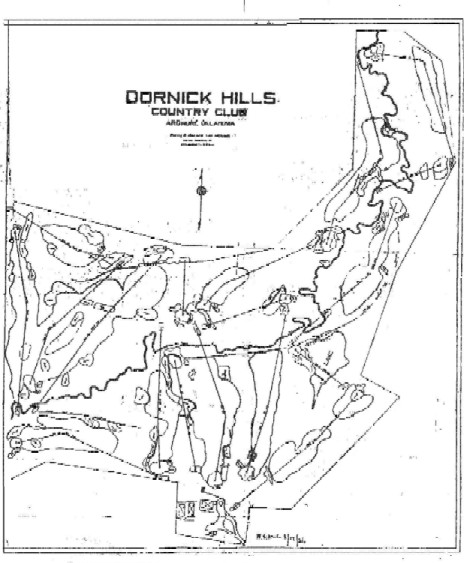
The routing of Dornick Hills as of 1926
DORNICK HILLS POST MAXWELL
It is believed that Maxwell may have come back to make some minor alterations to the course over the years after his 1936 alterations, but only to bunkers and possible bunker locations. A local architect did the next documented work in 1965. The work was a course-wide modification of the greens. The membership had decided that the green contours were too difficult to play and maintain at current standards for green speed. The green modification would set the precedent for allowing the course to be significantly being altered over the next 20 years. Perhaps the biggest change to the course was the elimination of the 8th green as it was originally designed. The 8th hole was originally designed as a modified Redan by Maxwell with the green rolling from left to right using the downslope of the terrain towards the creek some 30 yards away. Perry designed this hole so that the preferred line to use the terrain was protected by an angled cross bunker with the longest carry protecting the preferred landing spot. The shorter carry was to a piece of fairway that still allowed the player to use the terrain from short of the green with a delicate chip shot or a low running draw that would feed onto the putting surface. Another major change was the elimination of the alternate fairway on the 12th hole, through tree planting, leaving only the left side. Which left the negotiation of a tree a necessity for each player as they approached the green, instead of the original intent of the hole by Maxwell. This change was made due to the lack of an irrigation system for the alternate portion of the fairway.
Dick Nugent was hired in 1985 to come in and do a renovation of the front nine holes of the course and to create a driving range for the course. The most significant change to the course was on the opening two holes. Nugent took a long par 4 that played through a wash area and created a dogleg hole that plays to a green tucked tightly alongside the natural pond found on the course. This created the area that today is the driving range for the course and the original green is now a chipping green. The original tee is still in use and still provides a thrilling opening tee shot to any player. But as nice of a change as the 1st hole was, it created the opportunity to ruin a nice par 3 over the lake, which is now a green with some large containment mounding behind the green. A run through the rest of the course reveals only subtle changes to the remainder of the course. The 4th hole is a dramatic uphill par 3 that saw a major bunker renovation as part of the project. The 6th hole saw the elimination of the waste bunkering that created the main hazard from the tee. The 9th hole though was maintained with some small alterations to the bunkering leading up to the green. With the exception of the 1st, 2nd and 8th holes the front nine is still a reasonable facsimile to the original design and bears strong witness to the use of the terrain and the capabilities of Maxwell in designing a course. After the completion of the work, comments on the work appeared in the Daily Oklahoman on April 27, 1986.
Original bunkers were put back in place on four holes. The No. 1 green was moved in order to avoid a blind second shot and the tee box on No. 2 was moved so that the carts would drive north of a pond instead of south, where they had dangerously headed into the line of tee shots of No. 9 Greens were enlarged and given undulations on almost every hole on the front nine. The tee box on No. 6 was moved south to its original location, cutting some 30 yards off the distance. The result is a 500-yard, par 5 that dares golfers to go for the green on their second shot.
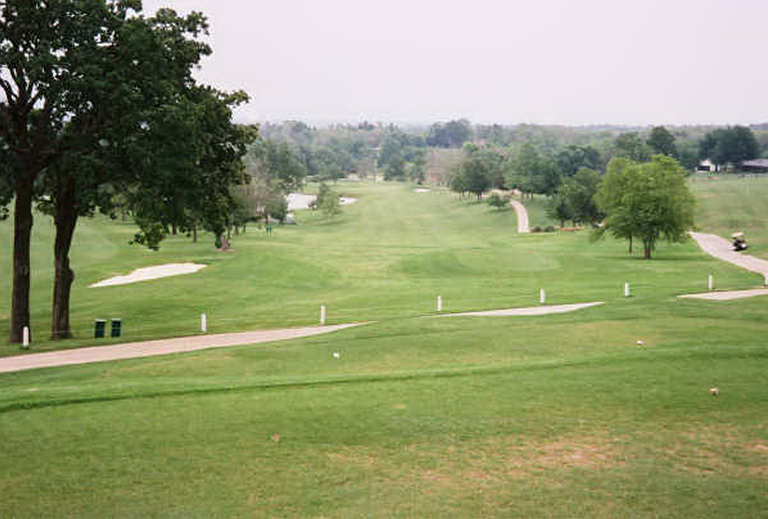
The 1st hole, after the 1986 renovation.
The back nine of the course has provided a much more controversial renovation, which was conducted by Jeffrey Brauer in 1992. The original scope of the job was similar in nature to the renovation on the front side of the course. The green renovation led to some bunker redesign and some mounding added to the course. The 10th green was moved slightly to help with exposure to the sun. The bunkering on the 11th hole was changed to a stair step style of two bunkers on the right side, which has since been eliminated and replaced by a single bunker short of the green and 10 feet below the putting surface in the face of the hill leading up to the green. The 12th and 13th holes saw some bunkering changes as well. The 14th hole saw a complete change to the green. The slope was maintained from the original design by Maxwell, but the lower portion of the green could not be used as it was just too steep for modern green speeds. Brauer created a new green with an increase in the step up to the green of one foot and implemented some stacked bunkers. The 15th green was an attempt at a Redan style green but lacked the necessary slope to really be qualified as that type in nature. The 17th hole saw the inclusion of a pond that replaced the waste bunker between the 7th and 17th greens. This was to help with drainage problems that were occurring in the 16th fairway adjacent to the 17th green. The 18th green also was flattened significantly for the same reasons as the 14th.
WHAT HAS CHANGED ON THE COURSE?
Below is a complete list of the changes to the course by hole since the changes by Maxwell in 1936.
Hole 1:The hole now is a slight dogleg to a new green situated by the pond. The original green is part of the practice area to the right of the opening hole.
Hole 2:The tee was moved from its original location and now presents a hole that is all carry to the new green surface. Additional mounding was added behind the green, presumably for safety reasons for tee shots from the 9th tee.
Hole 3: Tree growth has eliminated the opportunity to play the right side of the hole as intended with the slope of the land. The bunkering around the green has been changed.
Hole 4: The bunkering on the hole has been changed since the 1926 drawing. The green is now open in front.
Hole 5: The green originally only had the natural grass bunkering provided by the swale in front of the green. The current bunkering around the green was added by Nugent.
Hole 6:Tree growth, again, has virtually eliminated one of the primary lines of play on this hole. Along with this a large waste area or bunker has been eliminated over time. The bunkering currently in use was added by Nugent. This green like the 5th used a deep swale as the primary greenside defense.
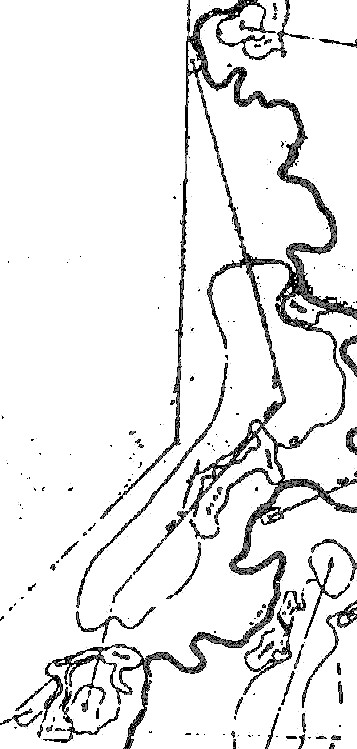
The original 6th was once full of interesting playing angles.
Hole 7: The bunker separating the 7th and 17th greens has been replaced by a pond.
Hole 8: The green contouring was eliminated in the 1965 renovation, as the front to back slope was seen as too difficult. The carry bunker short of the green has also been eliminated.

The missing carry bunker is outlined in red.
Hole 9: Tree growth has narrowed the playing corridor on this hole. Also a bunker short of the green has been added since Maxwell’s work.
Hole 10: The carry bunker for the 10th hole fairway was eliminated in 1965. The green was moved slightly in 1992.
Hole 11: The 11th tee was moved slightly to create separation from the 10th fairway. The bunkering on the hole is now relegated to one bunker short of the green. This has changed from the work done by Jeff Brauer as he left the course with stair step style bunkers along the right side of the green.
Hole 12: The right alternate fairway was eliminated over time with tree growth while the hole is much more of a dogleg than originally designed. Bunkering has also been changed dramatically on the hole by the Brauer work and prior.
Hole 13: The fairway width is much narrower today and significant bunker changes have occurred.
Hole 14: Aside from the tee nothing is as Maxwell left it. The green has been dramatically changed in contouring as stated above. The bunkering is totally different from the original design. The fairway is much narrower due to mowing patterns and due to tree growth.
Hole 15: The merged fairways with holes 13 and 16 have been eliminated. Bunkering also has been changed through out the hole. The green was recontoured by Jeff Brauer in 1992 to be somewhat like a Redan.
Hole 16: Aside from trees growing into the lines of play, the bunkering being eliminated and the fairway now a fraction of the width it was at the time of Maxwell, the hole is considerably still a fine example of Perry’s architecture on the course.
Hole 17: The green is now on the side of a pond instead of a large waste bunker.
Hole 18: The hole features some bunkering changes, but more importantly the merged fairway with the 10th hole has been eliminated. The green was also significantly flattened in an effort to maintain green speeds.
Other notes: The creek has been severely overgrown with trees since the 1930s and the resting place of Maxwell and Woods has become overgrown with brush and trees and has been obscured from the view of the golfer on the course.
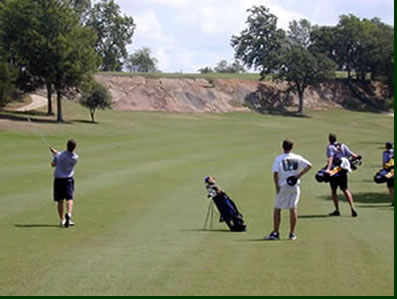
The famous ‘Cliff’ hole, the 16th
WHAT’S NEXT?
Now that we have analyzed the development of the course to where it is today, what do we do now? What recommendations would be made to help the course get back to what seems to be the original design intent and become more of what Maxwell envisioned and possibly become a better example of his design style and as a pillar of his career? In going around the course many opportunities still exist that can be used to create the feel of the course that Perry Maxwell left in the rolling terrain of Oklahoma. But one has to remember that Dornick Hills is a small town country club without the deep pockets of many of the top facilities in the country such as a Southern Hills. So inexpensive solutions would be the best for this situation.
Below is a list of areas that could be improved to help with the ambience and play of the course.
1. An effort to clear the area in front of the Maxwell-Woods cemetery that overlooks the 7th fairway. This area for many years was visible from the 1st and 10th tees and added a certain ambience, which increased the nostalgic feeling of the course. Restoring this to be seen from the clubhouse and allowing people to view the course from the same area would be a large benefit.
2. The mounding behind the 2nd green should be eliminated and use something subtler that blends better with the surrounding terrain.
3. A reconstruction of the bunkering by the third green to be closer to the original bunkering from the 1926 drawing and the elimination of trees along the right side would bring this hole back to the original design intent by Maxwell. Moving the bunkers to this position would allow the green contouring to be restored from the current bland putting surface and eliminating the trees would provide for multiple avenues of play from the tee.
4. A restoration of the large waste bunker that split the 6th fairway and elimination of trees along the creek. This was an original concept that Maxwell designed for the course that has been eliminated over time. This would make the hole a much more daring hole from the tee and force the player to decide his tactics there instead of allowing the player an open area to just bomb away towards and would also provide some more teeth to a short par 5.
5. The 8th hole was originally a unique twist on the famous Redan style of hole. Today this hole lacks the intended bite with the elimination of the carry bunker short of the hole. The outline of the bunker still remains today as seen from a present day aerial shot. This would make for a dramatic par 3 with a unique feel. The green would also require a mild recontouring to get the green similar to the original design.
6. The original 10th hole featured a carry bunker, which was eliminated for safety reasons as the 11th hole originally ran directly beside the 10th fairway. Due to the 11th fairway being slightly altered over time, this bunker could be restored and, along with some tree removal, would bring back the original option off the tee of a carry over the bunker and provide a much shorter and easier approach into the green for the daring player.
7. The 12th hole was at one time a fine hole with a double fairway. That could easily be restored with tree removal along the right side of the hole.
8. The 14th hole would be much improved with a little tree clearing near the green and along the right side of the hole.
9. Holes 13, 15 and 16 featured a merged fairway that provided a wonderful wide-open feel to the course that represented the farmland origins of the site. A large number of trees could be eliminated that would recover this feeling. Along with this, the 15th and 16th holes featured fairway bunkering that provided more challenge from the tee. Some sort of bunkering reconstruction would be a good replacement for the trees that could be eliminated.
10. The last item that could be recommended would be to eliminate many of the trees along the creek. This would open up many more views of the course and provide a more open feel to the site, much like Maxwell intended with his own course.
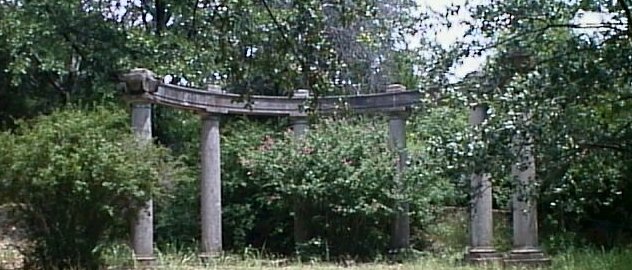
The Maxwell-Woods Cemetary
The purpose of this treatise is not to be overly critical of those that have made or been involved in the process of change on this once great course, but to bring to light the amount of change that has truly happened to the course and to ask the question, ‘What would it take to recapture what has been lost, if that is possible?’ This may help to bring about the changes needed to get back some of the qualities of the course that have been eliminated over the years. The architectural skill of Perry Maxwell was first demonstrated at Dornick Hills, the first course of his career and perhaps the one closest to his heart. It would be truly marvelous if we could see what his vision of this course was almost 90 years ago when he began building the first hole with an elevated tee looking out over the valley that would later become one of the pivotal golf courses in the history of Oklahoma. Also, without this restoration, it will be lost on many how much of an influence CB Macdonald had on Maxwell’s early design thoughts. Maxwell designed 70 courses over his career and many of the well-known courses (i.e. Southern Hills, Crystal Downs and Prairie Dunes) have had little disturbance since his hand touched them. Of his top designs, only Dornick Hills has had major renovations that have changed the original design intent of every hole on the course. Also, this course was truly unique in character and design from any other Maxwell course. If one looks at the next design of his career, Twin Hills in Oklahoma City, there are very few similarities in the design of the holes. Due to its significance to the career of one of the dominant architects of his era, the fact that it was his home course and that it was such a bold architectural step for its time in Oklahoma and in golf should warrant the question, ‘Why shouldn’t Dornick Hills be restored?’
The End








